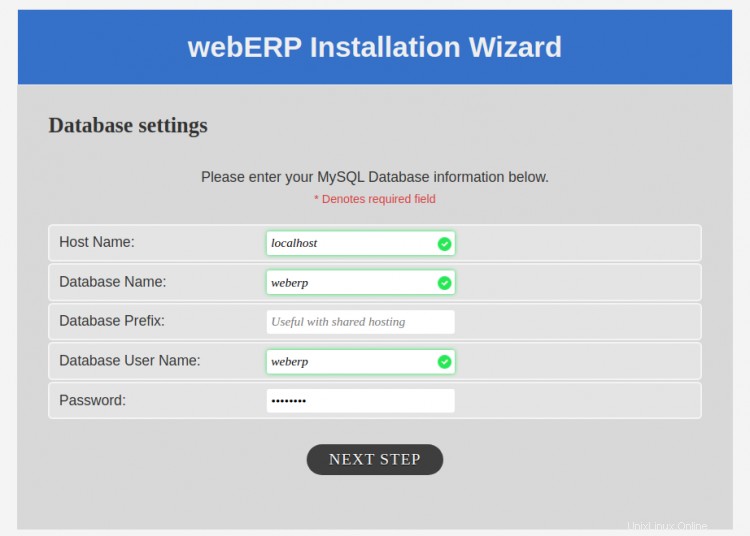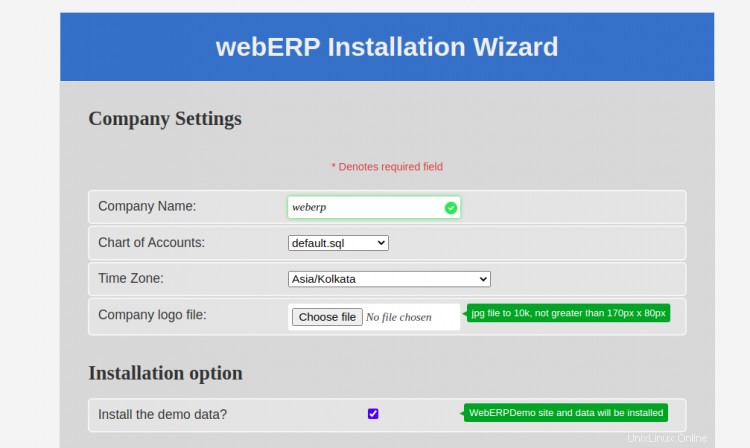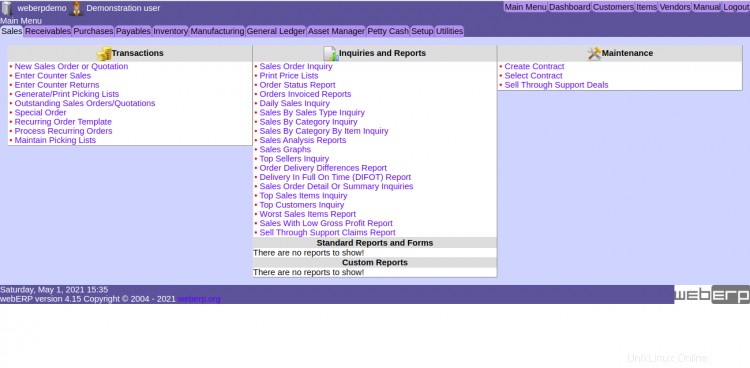webERP est un système de comptabilité et de gestion d'entreprise gratuit, open-source et complet basé sur le Web. Vous avez juste besoin d'un navigateur Web et d'un lecteur PDF pour utiliser le webERP. Avec webERP, vous pouvez gérer de nombreux éléments, notamment les bons de commande, la boutique en ligne, la fabrication, les ventes, le grand livre et l'expédition. Il est écrit en PHP et utilise MariaDB comme backend de base de données. Ce tutoriel vous montrera comment installer webERP avec Apache et Let's Encrypt SSL sur CentOS 8.
Prérequis
- Un serveur exécutant CentOS 8.
- Un nom de domaine valide pointé vers l'adresse IP de votre serveur.
- Un mot de passe root est configuré sur le serveur.
Installer le serveur LAMP
Tout d'abord, installez Apache, MariaDB, PHP et les autres extensions PHP à l'aide de la commande suivante :
dnf install httpd mariadb-server php php-mysqli php-curl php-json php-cgi php-xmlrpc php-gd php-mbstring unzip -y
Une fois tous les packages installés, démarrez les services Apache et MariaDB et autorisez-les à démarrer au redémarrage du système à l'aide de la commande suivante :
systemctl start httpd mariadb
systemctl enable httpd mariadb
Une fois que vous avez terminé, vous pouvez passer à l'étape suivante.
Configurer MariaDB
Ensuite, vous devrez définir un mot de passe root MariaDB et sécuriser l'installation de MariaDB. Vous pouvez le faire avec la commande suivante :
mysql_secure_installation
Répondez à toutes les questions comme indiqué ci-dessous :
Enter current password for root (enter for none): Set root password? [Y/n] Y New password: Re-enter new password: Remove anonymous users? [Y/n] Y Disallow root login remotely? [Y/n] Y Remove test database and access to it? [Y/n] Y Reload privilege tables now? [Y/n] Y All done! If you've completed all of the above steps, your MariaDB installation should now be secure. Thanks for using MariaDB!
Ensuite, connectez-vous au shell MariaDB avec la commande suivante :
mysql -u root -p
Une fois connecté, créez une base de données et un utilisateur pour webERP avec la commande suivante :
MariaDB [(none)]> create database weberp;
MariaDB [(none)]> create user [email protected] identified by 'password';
Ensuite, accordez tous les privilèges à la base de données webERP avec la commande suivante :
MariaDB [(none)]> grant all privileges on weberp.* to [email protected] identified by 'password';
Ensuite, videz les privilèges et quittez MariaDB avec la commande suivante :
MariaDB [(none)]> flush privileges;
MariaDB [(none)]> exit;
Une fois que vous avez terminé, vous pouvez passer à l'étape suivante.
Installer webERP
Tout d'abord, téléchargez la dernière version de webERP avec la commande suivante :
wget https://sourceforge.net/projects/web-erp/files/webERP_4.15.zip
Une fois le téléchargement terminé, extrayez le fichier téléchargé dans le répertoire racine Web d'Apache à l'aide de la commande suivante :
unzip webERP_4.15.zip -d /var/www/html
Ensuite, définissez l'autorisation et la propriété appropriées avec la commande suivante :
chown -R apache:apache /var/www/html/webERP
chmod -R 755 /var/www/html/webERP
Une fois que vous avez terminé, vous pouvez passer à l'étape suivante.
Configurer Apache pour webERP
Ensuite, vous devrez créer un nouveau fichier de configuration d'hôte virtuel Apache pour héberger le webERP. Vous pouvez le créer à l'aide de la commande suivante :
nano /etc/httpd/conf.d/weberp.conf
Ajoutez les lignes suivantes :
<VirtualHost *:80> ServerAdmin [email protected] DocumentRoot /var/www/html/webERP ServerName weberp.example.com <Directory /var/www/html/webERP/> Options FollowSymLinks AllowOverride All Order allow,deny allow from all </Directory> ErrorLog /var/log/httpd/weberp.org-error_log CustomLog /var/log/httpd/weberp.org-access_log common </VirtualHost>
Enregistrez et fermez le fichier lorsque vous avez terminé. Ensuite, redémarrez le service Apache pour appliquer les modifications :
systemctl restart httpd
Maintenant, vérifiez l'état de l'Apache avec la commande suivante :
systemctl status httpd
Vous devriez obtenir le résultat suivant :
? httpd.service - The Apache HTTP Server
Loaded: loaded (/usr/lib/systemd/system/httpd.service; disabled; vendor preset: disabled)
Drop-In: /usr/lib/systemd/system/httpd.service.d
??php-fpm.conf
Active: active (running) since Sat 2021-05-01 05:57:27 EDT; 13s ago
Docs: man:httpd.service(8)
Main PID: 4896 (httpd)
Status: "Running, listening on: port 80"
Tasks: 213 (limit: 25014)
Memory: 24.8M
CGroup: /system.slice/httpd.service
??4896 /usr/sbin/httpd -DFOREGROUND
??4898 /usr/sbin/httpd -DFOREGROUND
??4899 /usr/sbin/httpd -DFOREGROUND
??4900 /usr/sbin/httpd -DFOREGROUND
??4901 /usr/sbin/httpd -DFOREGROUND
May 01 05:57:27 centos8 systemd[1]: Stopped The Apache HTTP Server.
May 01 05:57:27 centos8 systemd[1]: Starting The Apache HTTP Server...
À ce stade, le serveur Web Apache est configuré pour héberger webERP. Vous pouvez maintenant passer à l'étape suivante.
Sécuriser webERP avec Let's Encrypt SSL
Ensuite, vous devrez installer le client Certbot pour installer Let's Encrypt SSL pour webERP. Vous pouvez l'installer avec la commande suivante :
dnf install letsencrypt python3-certbot-apache
Ensuite, obtenez et installez un certificat SSL pour votre domaine avec la commande suivante :
certbot --apache -d weberp.example.com
Il vous sera demandé de fournir votre adresse e-mail et d'accepter les conditions d'utilisation :
Saving debug log to /var/log/letsencrypt/letsencrypt.log Plugins selected: Authenticator apache, Installer apache Enter email address (used for urgent renewal and security notices) (Enter 'c' to cancel): [email protected] - - - - - - - - - - - - - - - - - - - - - - - - - - - - - - - - - - - - - - - - Please read the Terms of Service at https://letsencrypt.org/documents/LE-SA-v1.2-November-15-2017.pdf. You must agree in order to register with the ACME server. Do you agree? - - - - - - - - - - - - - - - - - - - - - - - - - - - - - - - - - - - - - - - - (Y)es/(N)o: Y - - - - - - - - - - - - - - - - - - - - - - - - - - - - - - - - - - - - - - - - Would you be willing, once your first certificate is successfully issued, to share your email address with the Electronic Frontier Foundation, a founding partner of the Let's Encrypt project and the non-profit organization that develops Certbot? We'd like to send you email about our work encrypting the web, EFF news, campaigns, and ways to support digital freedom. - - - - - - - - - - - - - - - - - - - - - - - - - - - - - - - - - - - - - - - - (Y)es/(N)o: Y Account registered. Requesting a certificate for weberp.example.com Performing the following challenges: http-01 challenge for weberp.example.com Waiting for verification. Cleaning up challenges Deploying Certificate to VirtualHost /etc/httpd/conf.d/weberp.conf Redirecting all traffic on port 80 to ssl in /etc/httpd/conf.d/weberp.conf - - - - - - - - - - - - - - - - - - - - - - - - - - - - - - - - - - - - - - - - Congratulations! You have successfully enabled https://weberp.example.com - - - - - - - - - - - - - - - - - - - - - - - - - - - - - - - - - - - - - - - - Subscribe to the EFF mailing list (email: [email protected]). IMPORTANT NOTES: - Congratulations! Your certificate and chain have been saved at: /etc/letsencrypt/live/weberp.example.com/fullchain.pem Your key file has been saved at: /etc/letsencrypt/live/weberp.example.com/privkey.pem Your certificate will expire on 2021-06-09. To obtain a new or tweaked version of this certificate in the future, simply run certbot again with the "certonly" option. To non-interactively renew *all* of your certificates, run "certbot renew" - If you like Certbot, please consider supporting our work by: Donating to ISRG / Let's Encrypt: https://letsencrypt.org/donate Donating to EFF: https://eff.org/donate-le
Vous pouvez désormais accéder à votre site Web en toute sécurité à l'aide de l'URL https://weberp.example.com .
Configurer le pare-feu
Ensuite, vous devrez autoriser les ports 80 et 443 à travers le pare-feu. Vous pouvez les autoriser avec la commande suivante :
firewall-cmd --permanent --add-service=http
firewall-cmd --permanent --add-service=https
Ensuite, rechargez le pare-feu pour appliquer les modifications :
firewall-cmd --reload
Accéder à l'interface Web webERP
Maintenant, ouvrez votre navigateur Web et accédez à l'interface Web de webERP en utilisant l'URL https://weberp.example.com . Vous devriez voir la page suivante :

Sélectionnez votre langue et cliquez sur ÉTAPE SUIVANTE . Vous devriez voir la page suivante :

Indiquez votre nom de base de données, votre utilisateur, votre mot de passe et cliquez sur ÉTAPE SUIVANTE . Vous devriez voir la page suivante :


Indiquez le nom de votre entreprise, votre fuseau horaire, votre nom d'utilisateur d'administrateur, votre mot de passe et cliquez sur INSTALLER bouton. Une fois l'installation terminée, vous devriez voir la page suivante :

Indiquez votre nom d'utilisateur et votre mot de passe d'administrateur et cliquez sur Connexion bouton. Vous allez être redirigé vers le tableau de bord webERP :

Conclusion
Toutes nos félicitations! vous avez installé avec succès webERP avec Apache et Let's Encrypt SSL sur CentOS 8. Vous pouvez maintenant explorer webERP pour plus de fonctionnalités et les implémenter dans votre environnement de production.